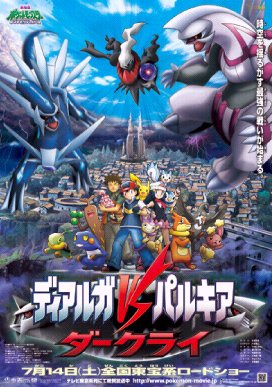NYT Article on PKMN
For many Pokemon fans this article will seem a bit out of touch with the Pokemon community and Pokemon fans in general but it does have some information about Pokemon USA's marketing strategy and goals for the Pokemon franchise.
Remember Squirtle and Jigglypuff? They’re Back
By WILL WADE -- Published: August 27, 2007
Playground fads come and go, as those who have found themselves with neglected collections of Beanie Babies can attest.
Pokemon video game characters on display at a shop in Tokyo. The company says that it has learned to be more selective about licensing its name.
But the Pokemon franchise, which enjoyed a long run of popularity in the late 1990s, is a rare example of a craze that has come back, for reasons that have as much to do with corporate maneuvers as they do with the tastes of the average 7-year-old.
Pokemon, which stands for “pocket monsters,” consists of a set of whimsical characters with supernatural powers who appear on trading cards, in video games and in television cartoons. And while most parents thought they had seen the last of Pikachu, Squirtle and Jigglypuff years ago, these days children are trading the cards on the playground again, playing Pokemon on their Game Boys and tuning in to a new animated series.
“We’re on fire,” said Holly Rawlinson, vice president of licensing and entertainment for Pokemon USA, a subsidiary of the Pokemon Company joint venture created by Nintendo and two other companies. Pokemon USA is responsible for managing the Pokemon name everywhere but in Asia.
Pokemon began in Japan in 1996 and reached the United States two years later. By 1999, it had become such a cornerstone of pop culture that the characters were featured on the covers of Time, The New Yorker and TV Guide; in 2001 the Macy’s Thanksgiving Day Parade added a Pikachu balloon.
But the attention led to overexposure. “One of the things about brands that enjoy enormous popularity is that they tend to also crash,” Ms. Rawlinson said.
Although the games and cards have always sold consistently to their core audience of boys, starting in about 2003 sales of licensed merchandise came to a standstill. “There was very little, if any, product on the shelves,” Ms. Rawlinson said. “It was a very tired time for us.”
So at the beginning of 2006, Pokemon USA set out to revive the brand. The coordinated effort was timed to culminate with big product introductions that began this spring.
First, Pokemon USA took control over important components of the franchise that had been managed elsewhere, including the trading cards that had been distributed by a division of Nintendo, and the cartoons, which had been handled by 4Kids Entertainment.
In April, Nintendo of America released two games for the hand-held Nintendo DS game system, Pokemon Diamond and Pokemon Pearl. In June, the Cartoon Network began the 10th season of the franchise’s cartoon series, this one called “Pokemon Diamond and Pearl.”
Also in June, Pokemon USA’s trading card unit began shipping a new series of cards featuring the 104 characters created for the Diamond and Pearl introduction (like Piplup, Chimchar and Turtwig) as well as many of the old characters.
It was the first time that new games, a new television season, and a fresh batch of cards were introduced in this country at roughly the same time, Ms. Rawlinson said. “All the elements support each other,” she said. “The kids play the Diamond and Pearl games and watch the new shows, and they immediately want to get the new cards.”
Another element of the revival has been a change in toy vendors, from Hasbro to Jakks Pacific, which introduced a new product line. Jeremy Padawer, Jakks’s vice president for brand marketing, said Hasbro had focused on a few main Pokemon characters, but his company is shipping toys that use more than 100 of the 500 characters.
The new merchandise was showcased this summer at the Toys “R” Us store in Times Square, which opened a temporary Pokemon boutique. Next month, Toys “R” Us plans to open Pokemon boutiques in its 585 other domestic stores, said Ronald D. Boire, the president of Toys “R” Us.
Sales of the trading cards this year have already exceeded sales for all of 2006, and by the end of the year are expected to triple last year’s total, according to Pokemon USA. The June 4 debut episode of “Pokemon Diamond and Pearl” on the Cartoon Network was the top-rated show that day for boys ages 6 to 11.
Total merchandise sales this year are expected to exceed $50 million, compared with less than $4 million last year, Ms. Rawlinson said.
After the overexposure issues of recent years, the company has learned to be more selective about licensing its name. “We get requests for all kinds of products, but now we turn a lot down,” Ms. Rawlinson said. Would-be Pokemon products that ended up on the reject list include diapers and gerbil cages.
In some ways, Nintendo’s success with Pokemon games is similar to that of its Wii gaming console. Breaking with the traditional strategy of aiming a console at gamers, Wii has become a best seller by aiming at people who did not play games, thus serving to expand the overall market.
The Diamond and Pearl games on Nintendo’s DS system, which let players compete against one another over the Internet, have done the same, according to Wilbert Rivera, a sales associate at a Manhattan GameStop store. Being able to battle against people all over the world “adds more challenge to the games, more depth,” he said.
The games are selling both to young fans and older, more experienced gamers. “Who’s buying it? Everybody,” Mr. Rivera said.
Source: http://www.nytimes.com/
de la PPN










0 Comments:
Post a Comment
<< Home